From the pixelated greens of 1989 to the OLED polish of 2025, Nintendo’s handheld journey isn’t just a tech evolution — it’s a cultural artifact. This is the complete story of Nintendo’s portable lineage, told through the systems, their defining games, and the emotions they carried in our pockets.
The Original Game Boy (1989)
Sometimes history begins in grayscale. When Nintendo launched the Game Boy in 1989, it wasn’t just releasing a device — it was lighting a spark. For kids of the late ’80s and early ’90s, this boxy brick of a machine was magic. It clicked. It chimed. It fit in your backpack like a secret portal to other worlds.
🎮 Suggested Reading

The Game Boy wasn’t powerful, not by any modern metric. Its screen was a ghostly pea-soup green, its sound chip crunchy and bright. But it was portable. Durable. Affordable. And paired with Tetris, it became a silent co-pilot on road trips, hospital beds, long flights, and under-the-blanket past-bedtime marathons.
TV ads at the time weren’t just showing features — they showed imagination. A boy on a bus playing baseball on a screen the size of a credit card. A girl flipping through puzzle games like they were part of her daydreams. It was our first taste of gaming freedom.
Fun Fact: The original Game Boy could survive drops, spills, and sandstorms. One unit damaged in a Gulf War bombing still works — and is on display at Nintendo’s NYC store today, forever looping Tetris.
Featured Game: The Legend of Zelda: Link’s Awakening — More than a portable entry, this 1993 classic told a story unlike anything in Zelda canon. Waking up on a mysterious island, Link slowly realizes that his world is a dream — and if he succeeds, he’ll lose it forever.

Its use of Mario enemies, quirky NPCs, and emotional payoff was unheard of in 8-bit games. Link’s Awakening didn’t just adapt Zelda to a smaller screen — it reimagined what handheld narratives could be.
Before we continue…
It wasn’t the Game Boy that made Nintendo fall in love with portability — it was Game & Watch.
In the early ’80s, long before cartridges and link cables, Nintendo released single-screen LCD handhelds like Ball and Donkey Kong. These were more than toys — they were blueprints. Simple, elegant, and obsessively replayable. For millions, they were the first video game they ever touched.
 And in 2020, Nintendo reminded us they hadn’t forgotten. The modern Game & Watch editions — complete with Super Mario Bros. and Zelda — brought that legacy full circle.
And in 2020, Nintendo reminded us they hadn’t forgotten. The modern Game & Watch editions — complete with Super Mario Bros. and Zelda — brought that legacy full circle.
Game & Watch walked so Game Boy could run.
Game Boy Pocket (1996)

By 1996, the Game Boy was already a cultural icon. But Nintendo wasn’t content to let it fade into history. Enter the Game Boy Pocket — slimmer, sleeker, and with a screen that finally ditched the green haze. It wasn’t a revolution, but a refinement — a love letter to those who’d worn down their original D-pads in the backseat of minivans and under cafeteria tables.
This was the version that slipped into jeans without a bulge, that made Pokémon trading on lunch breaks feel smooth and modern. In schoolyards, it wasn’t uncommon to see two kids crouched beside each other, cables tangled, eyes locked on screens barely bigger than a matchbox. For many of us, this was when handheld gaming became *social*.
Fun Fact: The Game Boy Pocket was the first model to use a proper black-and-white screen, improving visibility dramatically — but it still had no backlight. Players often gamed under lamps, car dome lights, or flashlights tucked under their chins.
Featured Game: Kirby’s Dream Land 2 — Often overshadowed by its more colorful successors, this monochrome marvel deepened Kirby’s mechanics and introduced animal companions like Rick, Coo, and Kine. Each partner redefined Kirby’s powers, turning familiar abilities into puzzle-solving tools.

Kirby’s second portable outing cemented the pink puffball’s status as a franchise star — playful, inventive, and surprisingly emotional. Its minimalist visuals let your imagination do the coloring.
Game Boy Color (1998)

It was still a Game Boy — but brighter. The Game Boy Color hit shelves in 1998 with a quiet confidence. No radical form factor. No new button layout. But inside that shell was something magical: color — finally.
Fun Fact: The Game Boy Color could apply pre-set color palettes to original Game Boy titles — letting classics like Super Mario Land and Tetris shine in new hues for the first time.
Featured Game: Dragon Warrior III — This enhanced remake of a Famicom legend brought a sprawling, open-ended RPG to handhelds. With party customization, time-based world events, and a class system that rewarded experimentation, it felt epic in the palm of your hand.
With vibrant towns, memorable music, and one of the strongest localization efforts of the era, Dragon Warrior III helped prove that RPGs weren’t just for consoles anymore — they belonged in backpacks, too.
Game Boy Advance (2001)
By 2001, Nintendo was ready to leave grayscale behind — and with the Game Boy Advance, they didn’t just upgrade visuals; they transformed the handheld into a full-blown 32-bit console. Suddenly, handheld games could look like SNES titles — or even better.
Wide, curved, and horizontal in design, the GBA felt futuristic. It introduced shoulder buttons, faster load times, and a leap in complexity. Developers quickly filled the library with ports of Final Fantasy, Donkey Kong Country, and Street Fighter — but the real magic came from brand-new gems that knew how to speak the GBA’s native language: fast, rich, and portable.

For many fans, this was their golden era. The GBA was a machine of morning bus rides and long summer trips. The sound of its cartridge clicking into place was a ritual. And if you were lucky enough to own the elusive GBA Link Cable, co-op and versus play opened up entire new worlds.
Fun Fact: The GBA’s graphics chip could natively replicate SNES Mode 7 effects — which is how Mario Kart: Super Circuit pulled off its signature track rotation and parallax scrolling.
Featured Game: Final Fantasy Tactics Advance — A rich tactical RPG with grid-based combat, job classes, and a surprisingly heartfelt story about escapism and loss. Set in the dreamworld of Ivalice, it lets players build squads, manage law systems, and slowly reshape the battlefield through smart planning and loyalty.

Years later, fans still debate its deeper meanings — about children escaping into fantasy and learning what it costs to come home. In handheld form, it became a quiet masterpiece.
Bonus Console: Pokémon Mini (2001)
Tiny. Weird. Charming. The Pokémon Mini is one of Nintendo’s most obscure handhelds — and one of the most collectible. Released in late 2001, this keychain-sized console only played Pokémon-themed cartridges, and it looked more like a Tamagotchi than a Game Boy.

But inside that simplicity was something magical. Games used rumble feedback, infrared communication, and even a real-time clock. There was no backlight, no color, and barely any screen real estate — but it captured the same essence of wonder that made the series a phenomenon.
Fun Fact: Only 10 official games were released for Pokémon Mini — including Pokémon Pinball Mini and Pokémon Party. Despite this, the system gained a strong homebrew community and emulator support years later.
Featured Game: Pokémon Puzzle Collection — Tiny in scale but surprisingly addictive, this minigame bundle featured pixel art of beloved Pokémon and required players to solve logic puzzles under time pressure.

There was no reason for this game to be as polished as it was — but Nintendo delivered, once again proving that even its smallest systems could surprise you.
I’m going a little off-topic…
But hear me out. This isn’t technically a handheld — at least not in the traditional sense — but if we’re talking about Nintendo’s portable past, we have to mention the Virtual Boy.
Released in 1995 and discontinued in less than a year, this red-and-black tabletop console was Nintendo’s first attempt at 3D gaming. The system was mounted on a stand, required you to peer into a binocular visor, and rendered all its games in monochrome red wireframes. It gave players headaches. It flopped commercially. And yet… it was bold.
The Virtual Boy didn’t just fail — it burned into gaming memory. And in hindsight, it foreshadowed Nintendo’s later risks with dual screens, motion control, and VR experimentation. It walked so Labo VR and 3DS depth sliders could run.
Not all legends shine. Some glow bright red… and vanish.
Nintendo DS (2004)

When the Nintendo DS was first revealed, it felt like a curveball. Two screens? A touchscreen? A clamshell design in the age of flip phones? Skepticism was rampant — but Nintendo wasn’t aiming for logic. It was aiming for legacy.
Released in 2004, the DS quickly proved itself not as a gimmick, but a generational shift. Its top screen handled traditional gameplay. Its bottom touchscreen invited creativity. Developers used it for maps, inventory, rhythm input, and sometimes — hilariously — blowing into the microphone to put out in-game candles.
Fun Fact: The DS is Nintendo’s best-selling console of all time — with over 154 million units sold globally. That’s more than the Game Boy. More than the Switch. It changed the industry.
Featured Game: Fire Emblem: Shadow Dragon — A reimagining of the original Famicom classic, this DS remake brought Marth’s origin story to a new audience. It combined tactical depth with streamlined UI, permadeath tension, and a haunting orchestral soundtrack that made every decision feel heavy.

This was strategy on the go — and it proved that handhelds could deliver moral complexity and large-scale warfare without compromise.
Nintendo DS Lite (2006)

If the original DS was the proof of concept, the DS Lite was the finished product. Launched in 2006, it took the quirky, bulky clamshell and polished it into something timeless — compact, glowing, elegant. For many, this was their *real* DS moment.
It was the version that appeared in fashion blogs. The one your cousin had in pink. The one your teacher didn’t mind you using during silent reading. With a brighter screen, longer battery life, and a refined form factor, the DS Lite became a lifestyle device. It wasn’t just a console — it was an accessory.
Fun Fact: The DS Lite sold over 93 million units, making it the highest-selling model in the entire DS line. It’s also one of the few consoles to have a truly massive global crossover appeal — from gamers to grandparents.
Featured Game: Elite Beat Agents — A rhythm game? A comic book? A surreal fever dream? Elite Beat Agents was all three — combining stylish tap gameplay with over-the-top visual storytelling. You didn’t just follow the beat — you saved the world with it.

The game is still a cult classic, often requested for remakes — a reminder that the DS Lite didn’t just enable casual gaming, but created its own weird and wonderful culture of touch-based experiences.
Nintendo DSi + DSi XL (2008–2009)
By the time the DSi arrived in 2008, Nintendo wasn’t just refining — it was rethinking. Gone was the Game Boy cartridge slot. In came two cameras, music playback, and the DSi Shop — Nintendo’s earliest digital storefront for portable consoles.

The DSi felt like the first handheld that truly understood the future: downloadable games, built-in apps, camera filters, and system software updates. And just one year later, the DSi XL brought that same functionality to a much bigger, more luxurious screen. It was made for older players, families, and those who valued screen real estate above all.
For some, this was a casual machine. For others, it was the bridge between childhood and modern gaming adulthood.
Fun Fact: The DSi’s built-in camera app let players add stamps, filters, and borders — years before Instagram. It was surprisingly ahead of its time for a pre-smartphone gaming device.
Featured Game: Shantae: Risky’s Revenge — Originally a DSiWare exclusive, this indie metroidvania revived a beloved Game Boy Color franchise with fluid animation, platforming depth, and vibrant spritework. It proved digital releases could be just as magical as retail boxes.

Years before “indie darling” was a buzzword, Shantae led the way — proving that downloadable handheld games could be timeless, beautiful, and critically adored.
Nintendo 3DS (2011)
When the Nintendo 3DS launched in 2011, it felt like science fiction — 3D visuals with no glasses, layered screens, augmented reality cards, and a whole new take on what “depth” could mean in portable play. Nintendo leaned hard into the idea that you could reach into the screen. And for a while, it really felt that way.

Early adopters remember the launch lineup being sparse, but the magic was in the details: StreetPass exchanges in train stations. AR card games that had you aiming the system like a camera. And later, a lineup of RPGs, simulations, and remakes that turned the 3DS into a golden era console.
The 3D slider wasn’t for everyone — and eventually, it became less central. But for those who used it, games like Kid Icarus: Uprising, Luigi’s Mansion: Dark Moon, and Fire Emblem: Awakening felt layered in a literal and emotional sense.
Fun Fact: In Japan, some fans would wander through crowded train stations just to collect new Mii avatars via StreetPass. It became a real-world meta-game — and one of the 3DS’s most beloved social features.
Featured Game: Shin Megami Tensei IV — A haunting, complex RPG where demons are allies, Tokyo is an apocalyptic warzone, and morality is never black and white. With deep turn-based mechanics, branching paths, and a chilling tone, this was portable JRPG storytelling at its most mature.

SMT IV wasn’t just a great RPG — it was an identity piece. For those who played it, the 3DS became a gateway to something darker, deeper, and unforgettable.
Nintendo 3DS XL & New 3DS Series (2012–2017)
The 3DS XL wasn’t just bigger — it was better. Released in 2012, it kept everything players loved about the original 3DS but wrapped it in a more comfortable, widescreen shell. This was the version that invited long sessions. RPGs breathed easier. Text was readable. Hands didn’t cramp.

Then came the New Nintendo 3DS in 2014 — a quieter release with deeper impact. It brought a faster CPU, extra shoulder buttons, and a second analog nub (the C-Stick). For the first time, select games like Xenoblade Chronicles 3D required this upgraded model, marking a subtle evolution in Nintendo’s handheld strategy.
In essence, the New 3DS was Nintendo’s testbed for modern performance scaling — a hint of what would become standard in the Switch era.
Fun Fact: The New Nintendo 3DS featured swappable faceplates in Japan and Europe — making it Nintendo’s most customizable handheld to date. Collectors still hunt for rare designs today.
Featured Game: Monster Hunter Generations — With slick animations, local co-op, and an absurd amount of armor sets, this entry became a fan favorite for both veterans and newcomers. It made full use of the New 3DS’s extra controls and boosted loading speeds.

It wasn’t just about the monsters — it was the community. Friend groups formed. Tactics were shared. And suddenly, the 3DS felt like a hunting lodge in your pocket.
Nintendo Switch Era (2017–2024)
When the Nintendo Switch launched in 2017, it wasn’t just a new console — it was the death of the divide. For the first time, a Nintendo system was both handheld and home console. You could dock it, undock it, throw it in a bag, or prop it up at a party. It didn’t ask you to choose.

In many ways, the Switch carried the soul of every handheld before it — the physicality of Game Boy, the touchscreen spirit of the DS, the community DNA of StreetPass. But it did it with HD visuals, detachable Joy-Cons, and a focus on seamless, uninterrupted play. It became the canvas for Breath of the Wild, Smash Ultimate, and Animal Crossing’s global lockdown phenomenon.
Then came the iterations. The Switch Lite (2019) trimmed the fat for pure handheld play. The Switch OLED (2021) added brilliance, depth, and a premium finish to the display. Each one pushed the envelope without breaking the identity — “play anywhere, anytime, with anyone.”
Fun Fact: With over 139 million units sold, the Nintendo Switch is on pace to become the most successful console of all time — handheld or otherwise.
Featured Game: Triangle Strategy — This HD-2D tactical RPG became one of the Switch’s most distinct artistic triumphs. Blending isometric strategy gameplay with branching morality and political intrigue, it felt like the spiritual successor to Final Fantasy Tactics and Fire Emblem in one beautifully pixel-lit package.

It reminded us that handheld play didn’t have to be smaller — it could be grand, dramatic, and just as breathtaking as anything on a 4K screen.
Nintendo Switch 2 (2025)

The Switch 2 isn’t just another system — it’s a baton pass. Released in 2025, this new generation inherits the legacy of Game Boy, DS, and Switch before it — a lineage of touchscreens, pixels, portability, and play-anywhere philosophy. But now, it’s magnetic, 4K-ready, and built with modern infrastructure from day one.
Its Joy-Cons snap on sideways using magnetic inserts. Its dock mode outputs at 1440p. And it’s fully backwards compatible with the original Switch — both digitally and physically — a rare move that honors the decade-long ecosystem players have already built.
Online enhancements, a new video capture system, and seamless local pairing tech put the Switch 2 in a different league. It’s a console designed not just for Nintendo fans, but for a generation that grew up modding DS Lites, speedrunning on 3DS XLs, and farming shiny Pokémon on GBA SPs.
Fun Fact: Switch 2 consoles in Japan are expected to surpass 1.2 million units at launch, based solely on pre-order lotteries — a record for any Nintendo handheld in history.
Featured Game: Castle of Heart: Retold — A deep-cut cult favorite reborn, this remaster fuses classic 2.5D combat with modern physics, improved controls, and Switch 2’s tactile feedback. It’s not just a remake — it’s a resurrection.

By spotlighting a forgotten knight, Castle of Heart reminds us why Nintendo handhelds endure: they’re not just machines. They’re vessels for myth, memory, and rediscovery.
We’re just getting started.
Final Thoughts
From monochrome bricks to magnetic precision, Nintendo’s handheld journey isn’t just about processors or screens — it’s about childhoods remembered, friends made through StreetPass, cartridges traded at lunch, and games that became personal history. The Switch 2 isn’t the end of this journey — it’s a fresh save file.
Want a taste of what nostalgia feels like in real time? Check out our Switch 2 launch day retrospective — it’s the midnight magic that handhelds were made for.
Want a taste of what nostalgia feels like in real time? Check out our Switch 2 launch day retrospective — it’s the midnight magic that handhelds were made for.


